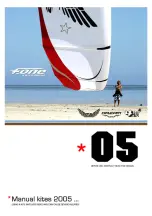
ASAP Canopies’ S-Series Powered Parachute Canopy Owner’s Manual May 10, 2010 Page 31 of
33
EMERGENCY TREE LANDING
If it is not possible to land in an open area and only tree tops are available for landing, steer into the wind
above the tree tops and do a normal landing approach as if the tree tops are your landing spot. Flare as
for a normal landing. On impact hold your legs together and protect your face with your arms.
After any emergency landing it is very important to check all the lines, line measurements, and the canopy
for damage.
WATER LANDING
As you approach landing, you may want to release part of your seatbelts. Just before landing, release the
remaining buckle. It is advisable to enter the water downwind if winds are not too high. Let the canopy
rotate completely forward until it hits the water with the leading edge openings; the air inside will then be
trapped, forming a big air mattress and giving the pilot more time to escape. Less water will enter the
canopy this way, making the recovery much easier. Get away from the powered parachute and lines as
soon as possible, to avoid entanglement. The canopy should be carefully inspected after a water landing,
since it is very easy to cause internal damage to the ribs if the canopy is lifted while containing water.
Always lift the wet canopy by the trailing edge, not by the lines or top or bottom surface fabric.
PACKING
Spread the canopy completely out on the ground. Separate the lines to the left and the right side of the
powered parachute canopy. Gather up the trailing edges with the lines on top of the chute and line socks
in place. Begin stuffing the chute into the bag from the trailing edge towards the leading edge so that air is
automatically forced out of the canopy as it is stuffed into the bag.
MAINTENANCE & CLEANING
Cleaning should be carried out with water and if necessary, gentle soap. If the powered parachute canopy
comes in contact with salt water, clean thoroughly with fresh water. Do not use solvents of any kind, as
this may remove the protective coatings and destroy the fabric.
STORAGE
When the powered parachute canopy is not in use, the powered parachute canopy should be stored in a
cool, dry place. A wet powered parachute canopy should first be dried (out of direct sunlight). Protect the
powered parachute canopy against sunlight (UV radiation). When outdoors for the day keep the powered
parachute canopy covered or in the bag. Never store or transport the powered parachute canopy near
paint, gasoline, diesel fuel or any other harmful chemicals.
DAMAGE
Spinnaker repair tape (for non-siliconized cloth) can repair small tears in the sail (up to 5cm). A
professional repairer should repair greater damage.
GENERAL ADVICE
A qualified person or agent of the company should check the powered parachute canopy every year.
The powered parachute canopy is carefully manufactured and checked by the factory. Never make
design changes to the canopy or the lines. Changes can introduce dangerous flying characteristics and
will not improve flying performance.
Do not put the powered parachute canopy in direct sunlight when not necessary. In order to protect the
powered parachute canopy during transportation or waiting time we recommend keeping the canopy in
the lightweight storage bag provided.
•
If you have any doubts about flying conditions-do not begin.
•
If you have any questions, please contact your dealer or us.
•
Lastly, be equipped with safety equipment and a helmet on every flight.
Summary of Contents for Mustang S380
Page 15: ...ASAP Canopies S Series Powered Parachute Canopy Owner s Manual May 10 2010 Page 15 of 33...
Page 18: ...ASAP Canopies S Series Powered Parachute Canopy Owner s Manual May 10 2010 Page 18 of 33...
Page 19: ...ASAP Canopies S Series Powered Parachute Canopy Owner s Manual May 10 2010 Page 19 of 33...
Page 20: ...ASAP Canopies S Series Powered Parachute Canopy Owner s Manual May 10 2010 Page 20 of 33...



































